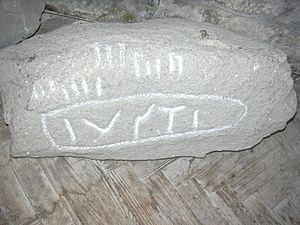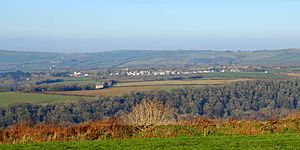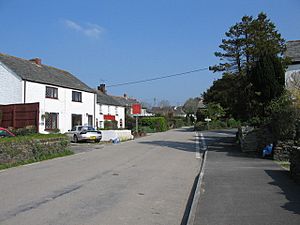St Kew facts for kids
Quick facts for kids St Kew
|
|
|---|---|
| Population | 1,145 (United Kingdom Census 2011) |
| OS grid reference | SX021769 |
| Civil parish |
|
| Unitary authority | |
| Ceremonial county | |
| Region | |
| Country | England |
| Sovereign state | United Kingdom |
| Post town | BODMIN |
| Postcode district | PL30 |
| Dialling code | 01208 |
| Police | Devon and Cornwall |
| Fire | Cornwall |
| Ambulance | South Western |
| EU Parliament | South West England |
| UK Parliament |
|
St Kew (Cornish: Lanndohow) is a village in Cornwall, England. It is also the name of the wider area, called a civil parish. This parish includes the main village, St Kew, and a nearby place called St Kew Highway (Fordh Lanndogho).
The area is named after a Welsh saint, Saint Kew. She might have been the sister of Saint Docco, who started a monastery near the village. The church in St Kew, built in the 1400s, is now dedicated to Saint James.
Contents
What's in a Name? The Story of St Kew
St Kew is mentioned in history earlier than any other place in Cornwall. It appears in the Life of St Samson, a very old book about a saint. This book tells how Saint Samson visited a monastery called Docco in the early 500s. Saint Samson came from Wales.
Saint Docco is said to have come to Cornwall from Wales with his sister, Saint Kew. They started a religious center called Lan Docco. Legend says that Saint Kew promised to build a church where a troublesome bear was killed. This spot is believed to be where the current church stands today. Saint Kew's special day is celebrated on February 8th.
Over time, the name Lan Docco became shorter, turning into Lannou or Lannow. Records from the 1100s use this shorter name. There was a small chapel dedicated to Saint Kew at Lannou before 1373. By 1575, official records called the place "Lannow alias St Kew." This shows how the old name slowly changed to the one we know today.
A Look Back: History of St Kew
St Kew was a large estate during the time of the Domesday Book. This was a big survey of England done in 1086. The records show that St Kew had enough land for 22 ploughs. There were 59 villagers and 26 smaller farmers. They had 20 ploughs, plus meadows, pastures, and a large woodland. There were also 9 cattle and 120 sheep.
For many years, St Kew was owned by Plympton Priory and later by the Bishop of Exeter. After the dissolution of the monasteries (when King Henry VIII closed many religious houses), the land was held by the Molesworth family.
At a place called Bokelly, there is a barn from the Tudor period (1485-1603). The farmhouse there was built in the 1500s and updated later. In the late 1500s, it was home to William Carnsew, who wrote about visiting other important houses in Cornwall.
Pengenna is a manor house from the 1600s. Another estate, Treharrack, was sold in 1879. It included a large house, stables, and gardens. The Treharrick family owned this land long before the English Reformation.
There are also old piles of waste from the Trevinnick mine. This mine produced antimony, lead, and zinc in the late 1800s.
Exploring the Church of St James
The parish church of St James is in the village of St Kew Churchtown. It was built in the 1400s. The church has beautiful stained glass windows, including one that shows the Passion of Christ. These windows were repaired in 2005. A famous expert, Nikolaus Pevsner, said the windows were the most "memorable" part of his visit.
He also liked the pulpit, which is a raised stand where sermons are given. It's from the Elizabethan era (late 1500s) and has lovely decorations. Inside the church, you can see carved stone decorations, a special wooden ceiling, and a font from the 1400s used for baptisms. There's also a curious Ogham stone, which is an ancient stone with special markings, found nearby.
The church was originally dedicated to Saint Docco. But in the mid-1400s, the dedication changed to Saint Kewa (Saint Kew) when the church was made bigger.
Gallery: The Church of St James
St Kew Highway Railway Station
The railway station at St Kew Highway opened on June 1, 1895. It was part of the North Cornwall Railway. The station had two platforms and a siding for goods trains. The station building was made from local stone.
In 1939, the railway line was extended. However, the goods services stopped in 1964. The station became unmanned in 1965 and closed completely on October 3, 1966. The old station building is now a private home.
Cornish Wrestling Tradition
For hundreds of years, wrestling tournaments have been held in a field near the St Kew Inn.
One famous wrestling match took place in St Kew in the 1820s. A wrestler named Abraham Bastard beat the much bigger and more famous Polkinghorne. This victory helped Bastard become a preacher later in life.
Proctor Grose, from St Kew, was known as the strongest man in Cornwall in the early 1800s. He won many wrestling prizes in both Devon and Cornwall.
Walmsley Sanctuary: A Haven for Birds
The Cornwall Birdwatching and Preservation Society owns the Walmsley Sanctuary. This special area covers over 20 hectares (about 50 acres) along the River Amble. The river flows into the River Camel. The sanctuary has two bird-hides, which are small buildings where people can watch birds without disturbing them.
This sanctuary is very important for birds that spend the winter there, especially wading birds and wildfowl. The sanctuary was bought in 1939 with money left by Dr Robert Garrett Walmsley. He wanted the society to create a safe place for migrating birds in Cornwall.
St Kew ACE Academy: Learning and Growing
The St Kew ACE Academy, which used to be called St Kew Community Primary School, has great outdoor spaces. These include a playground for younger children, a large playground with a quiet garden, and a playing field with adventure equipment. There's even a science garden!
The school building is all on one level. It has three classrooms, extra teaching areas, a pre-school room, a library, a reception area, and a hall with kitchen facilities. The school first started in the Parish Hall around 1900. It moved to its current location in 1928. A new part was added to the school in 1991. The school is now part of Kernow Learning, a group of primary schools in Cornwall.
Famous People from St Kew
- Sir Edward Braddon (1829–1904) was born in St Kew. He later became the premier (leader) of Tasmania, an island state in Australia.
- Reverend Thomas Hutton (1566–1639) was the Vicar of St Kew from 1607 until his death. He also wrote a book in 1605.












